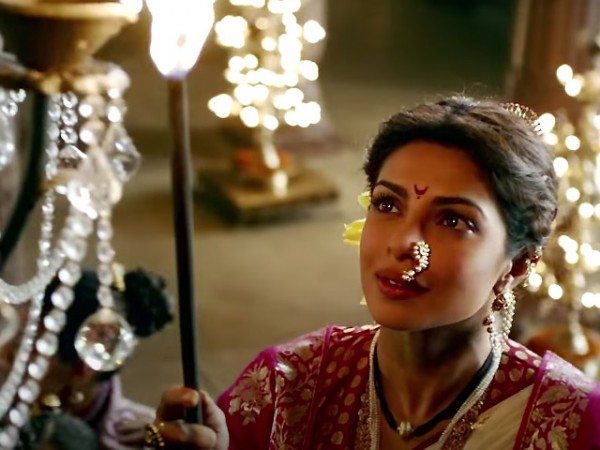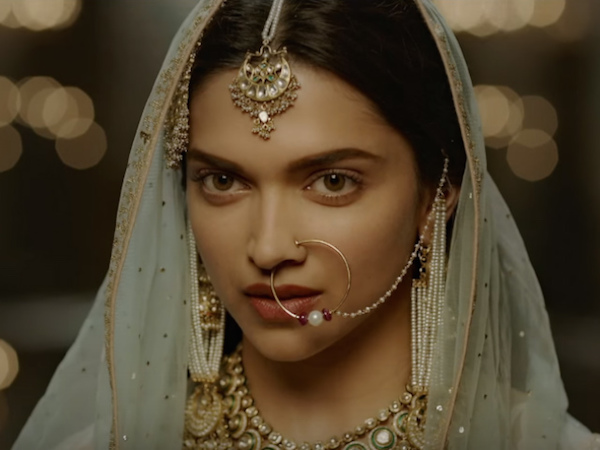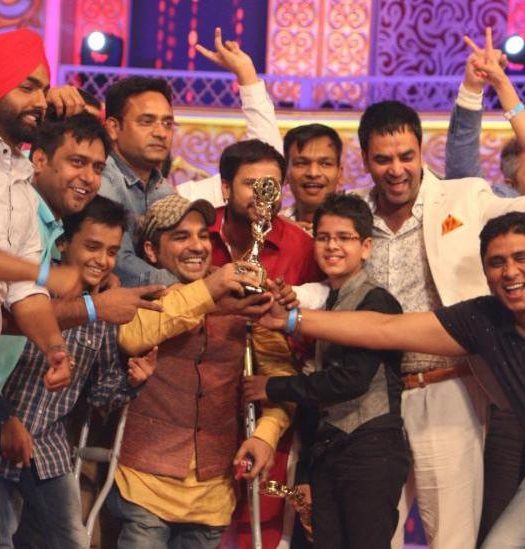Bajirao Mastani is completely my way of visual storytelling
Every time he gets on the Cinematographer’s chair, he weaves a spellbinding visual delight. And most recently he created magic in Sanjay Leela Bhansali’s historical magnum-opus, Bajirao Mastani. In an exclusive chat, the National Award-winning cinematographer Sudeep Chatterjee reveals what he conjured up to bring alive a surreal period drama.

DOP Sudeep Chatterjee with Sanjay Leela Bhansali on the sets of Bajirao Mastani
Firstly, congratulations on Bajirao Mastani. How does it feel as everyone is raving about the way the film is shot?
I don’t believe that a DOP has a signature style of shooting; it always comes from the screenplay. But there is an identity, and my identity is that while being faithful to the screenplay, I try to do a variety of work, venture into new grounds and do something that hasn’t been done before. Every job doesn’t give the opportunity to be instinctive and have creative freedom. Sometimes you do a job that is required. But once in a while you get a film where the director gives you the freedom to interpret the visual language in a certain way, which I got on Bajirao Mastani. Then, you try something that hasn’t been done before, and when that gets appreciated it is the biggest joy. This is how I wanted to tell the story and people have liked it, so it makes it fulfilling. I can say that Bajirao Mastani is so completely my way of visual storytelling. Even Chak De… and Guzaarish were such films. Right from the word go we tried to develop a unique visual language for Bajirao Mastani.
READ: I HAVE GROWN WITH BAJIRAO SAYS RANVEER SINGH
Theoretically, what was the visual language you conceived for Bajirao Mastani?
When working with Sanjay (Leela Bhansali), whatever be the first idea, you have to chuck it out of the window! So, we started with what was the period and the people. Marathas were very basic and middle-class, matter-of-fact, no-nonsense and non-grandiose people. So, the visual language had to be like what the Marathas were – elegant, dramatic, powerful but basic. We wanted a sense of dignity in everything – from the colors to props to framing. But how we arrived at the visual language was an interesting journey.
Tell us about the journey to arrive upon the visual language.
Initially, all our conversations regarding the look of the film were abstract. We’d keep talking generally and didn’t look at references. In the beginning we traveled to a lot of places like Satara, Bhor, Pune, Kolhapur and Sholapur to see the Maratha architecture. We also went to Madhya Pradesh and looked at palaces and forts there. As we travelled we got acquainted with the spaces and culture and that’s when Sanjay introduced me to the characters. He would tell the vibe each character’s rooms would give out. Such conversations led to the language. So for me the characters fell in place before the story. Then, we started looking at real places without worrying about the lighting or color palate. I would take pictures and later discuss it with Sanjay. That’s how we derived the visual direction we wanted to go in.
Once a basic foundation was in place, we then started looking at references. We started off with paintings by Raja Ravi Verma, Ganganendra Nath Thakur, Abanindranath Tagore and Rembrandt, Caravaggio, Vermeer, Botticelli, etc. Sanjay really liked Ganganendra Nath Thakur’s paintings; I think the color palette for the film has come straight from his paintings. Sanjay showed me a lot of black and white Marathi cinema that I hadn’t seen, films by V Shantaram, Mehboob Khan and we revisited Pakeezah as well.
Simultaneously, Sanjay started introducing me to the world of music for the film. So, the introduction to this film was very unique. We began talking about characters, their spaces, abstract references, and then came music. Once all this was done we began creating a look board for the film. After our discussions and travel, Sanjay asked to me return with a look board for the one-line screenplay. So, I came up with references of paintings, film scenes, photos of real spaces, whatever I thought would visually define the scene. Sanjay also created a similar look board. Eventually we narrowed down on the visual references. After the final look board was ready, we introduced it to the Production Designer, Costume Designer, Assistant Directors and Assistant Camera to start work. It was an extensive six-eight months of solid pre-production where everyone knew visually in which direction the film is going.
READ: EACH CHARACTER HAS ITS OWN SHADE WHICH WE HAVE TRIED TO BRING OUT IN BAJIRAO MASTANI

Since the film is VFX heavy, how did you go about shooting those scenes?
A couple of complex VFX sequences, like the war sequences, had to be story-boarded. The big challenge was the Bundelkhand war sequence that had to shot at twilight. Sanjay didn’t want to do a day war sequence as it is common. And Marathas were guerrilla fighters and fought a lot at night. We knew it would be tough to do the night scenes as visibility would be a problem, so we opted for twilight lighting. Of course, we shot it Day for Night. A lot of foreground fire elements were shot in studios and composited because fire wouldn’t show in day light. We had a second unit that shot only skies. Everything was pre-decided – what would be shot on real locations, what was to be shot in studios, what had to be CG and composited in the scene. We had joint meetings with the Art, VFX and Action team. After Sanjay and I had finalized the story board, we would bounce it off to people at the meeting to figure how much would be shot real and what would be composite and computer graphics. With each frame we had a long list of notes. Based on that my team would make a shot plan.
What was the camera and lighting set up employed for the film?
I had a terrific experience with Alexa on Dhoom 3 and Baby, so I chose Alexa XT with in-built Raw. I used Master Prime lenses. Mostly we shot with block lenses except once or twice when we used zoom lenses. Sanjay believes that even when an actor is performing it is not that they are telling the story alone, even the background and walls are narrating it. For instance a lot of Deepika (Padukone)’s close-ups are done in wide lenses, either 35mm or 25 mm.
In terms of lighting, we had to remember two to three things – in the period the film is set in there was no electricity and the lighting was flame lit. They used large bowls of fire for outdoors and diyas, chandeliers, candles, etc. for indoors. We had to keep the lighting similar. So, we used similar lighting sources that were controlled by flicker boxes to keep a note on the flicker of flames. We used fillers for outdoors. We also used mirchi lights (the lights people put up during Diwali) as they could be easily concealed and exuded the soft lighting suitable for the scenes. I think this is the first time someone has used mirchi lights for shooting a film.
READ: FIVE THINGS WE LEARNT FROM BOLLYWOOD IN 2015
Can you tell us about the shooting locations?
We shot extensively in Jaipur (Rajasthan), Wai (Maharashtra) and the rest were sets.
How did you plan shooting in the opulent Aaina Mahal?
When the Aaina Mahal set was being constructed we were present and working in tandem with the Production Design team to plan out the camera and light placements on the set. So that smoothed out the shoot on the D-day. The mirchi lights worked well to light up this space.

Deepika Padukone as Mastani
Looking back at the film, do you think you would do anything differently?
Yes. We needed more time – another one-two months for post-production. The post-production got hurried because of the release date pressure. Fortunately, our VFX supervisor Prasad Sutar and I were on the same page aesthetically but there was so much work to be done. The climax was shot last so he was doing heavy-duty stuff till the end. I also feel that due to the lack of time we hurried through the Naseer jung war. There was a fabulous lavani song, Fitoori, which we couldn’t shoot. For a film like Bajirao Mastani you need more time. The first unit shot for about 217 days and the second unit for 30 days. But it was less.
Please tell us about your team.
I have had the same team since a while. Anirban Chatterjee was the Associate Cinematographer, Shyam Shukla was the Gaffer, Anamolu Praveen Kumar, Huentsang Mohapatra and Parth Sayani were assistant cinematographers. Prasad Sutar was the VFX supervisor and Ashirwad Hadkar was the DI Colorist. I also have to mention Mahesh Limaye, who headed the second cinematography unit. I told Sanjay that I needed an equally talented cinematographer for the second unit and Mahesh was kind enough to head it.
READ: AS A DIRECTOR WHAT YELLOW GAVE ME IS SOMETHING I CAN’T EVEN EXPRESS
What were the technical challenges on this film?
Everything was a challenge and nothing was a challenge. We had done solid pre-production and detailed planning so all the complex scenes too went off well.
Which is your favorite scene from Bajirao Mastani?
You will be surprised to know that my favorite scenes don’t have technical wizardry. In fact these are scenes that are simple but powerful emotionally. The scene when Kashibai goes to meet Mastani for the first time and another one is where Ranveer Singh, with his two sons, has an altercation with his mother, played by Tanvi Azmi. I think these two scenes are my favorite because they are emotionally charged.


